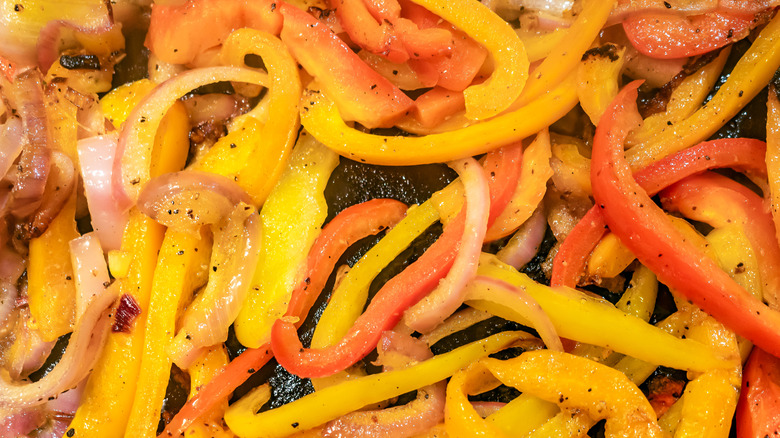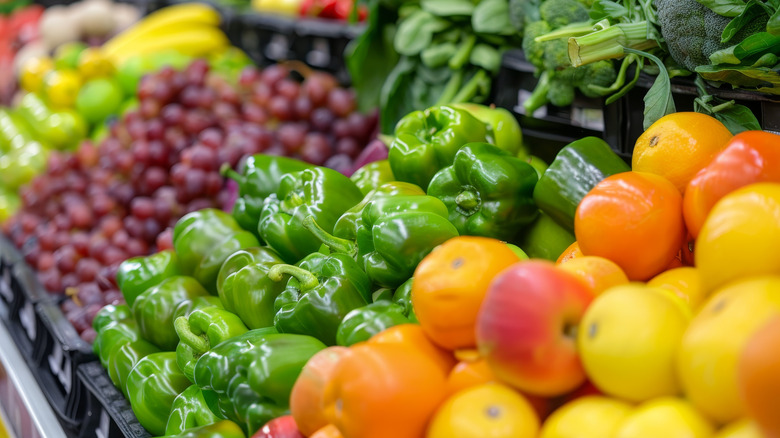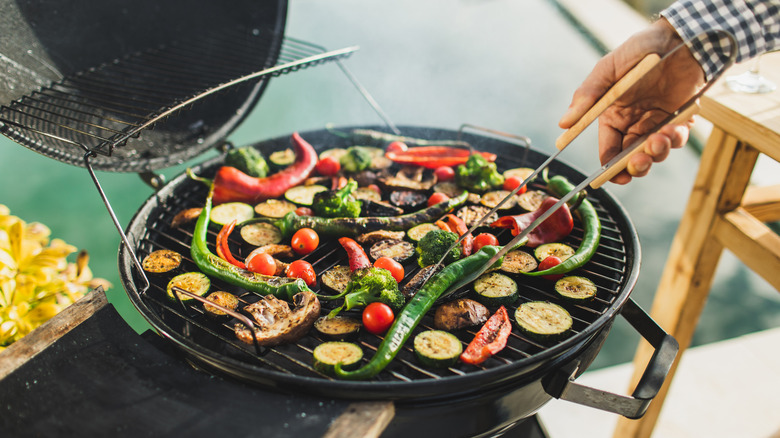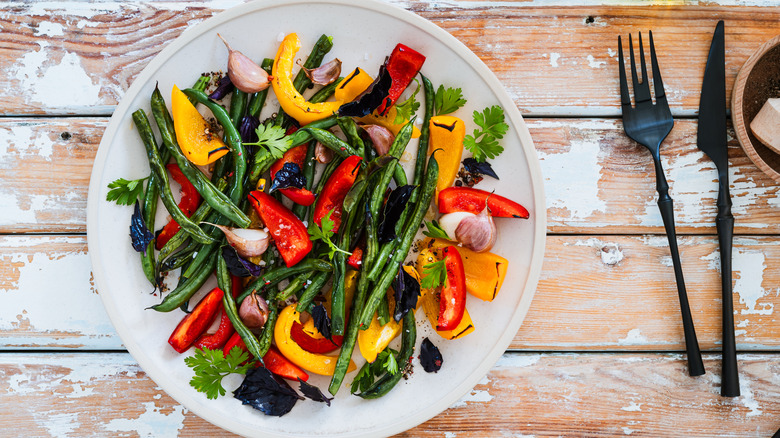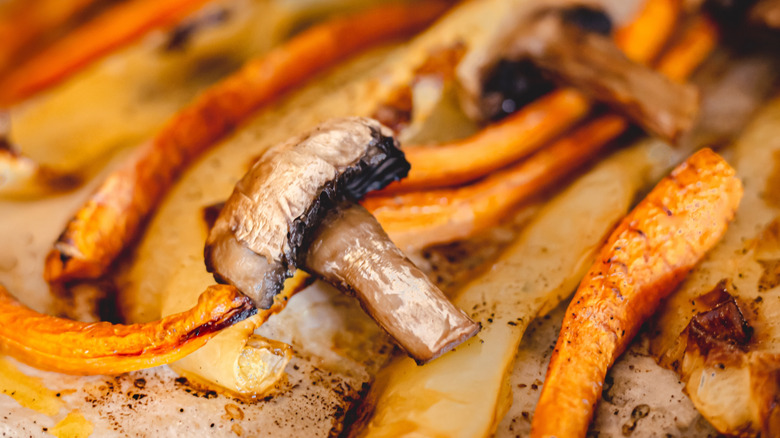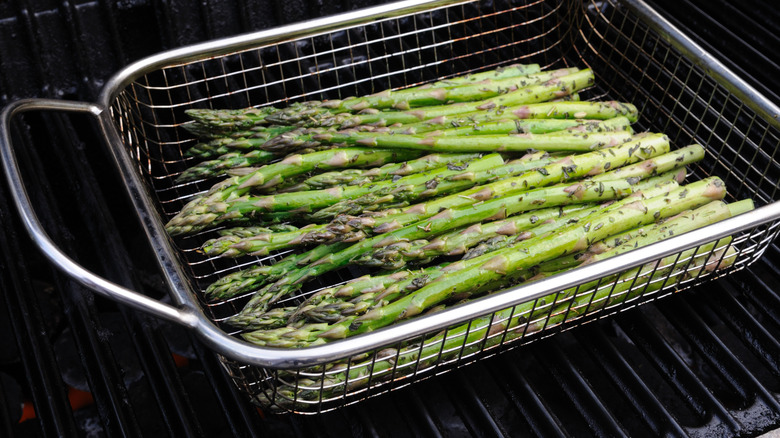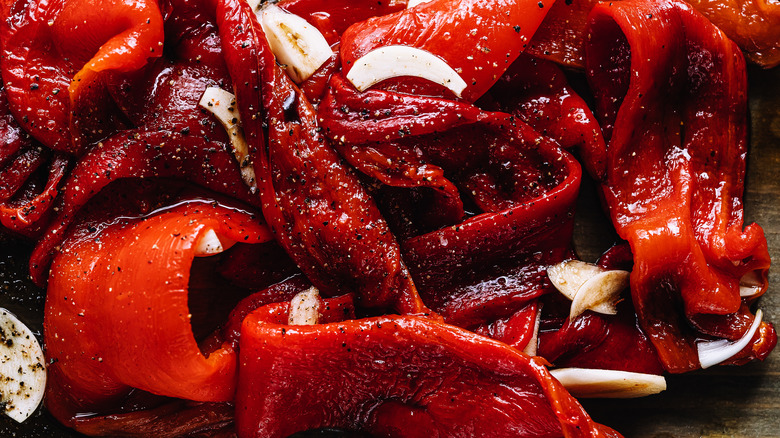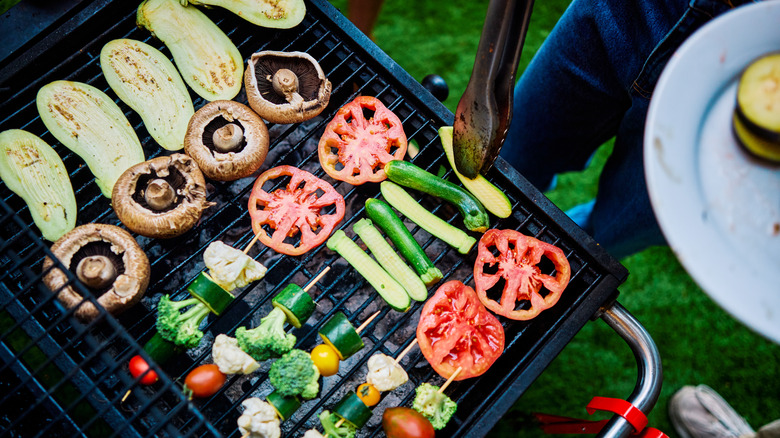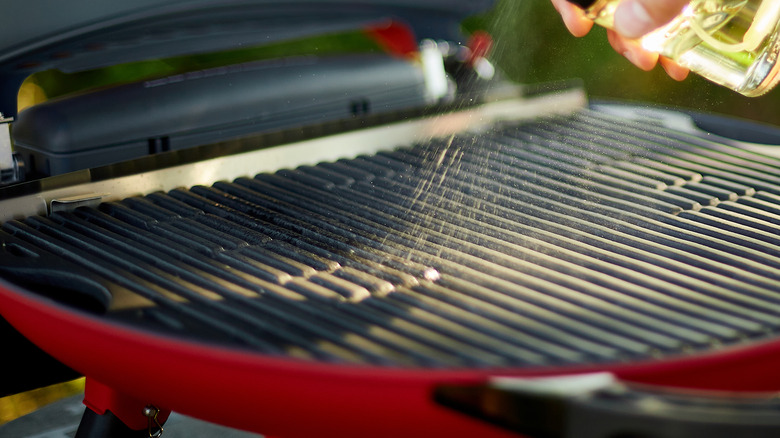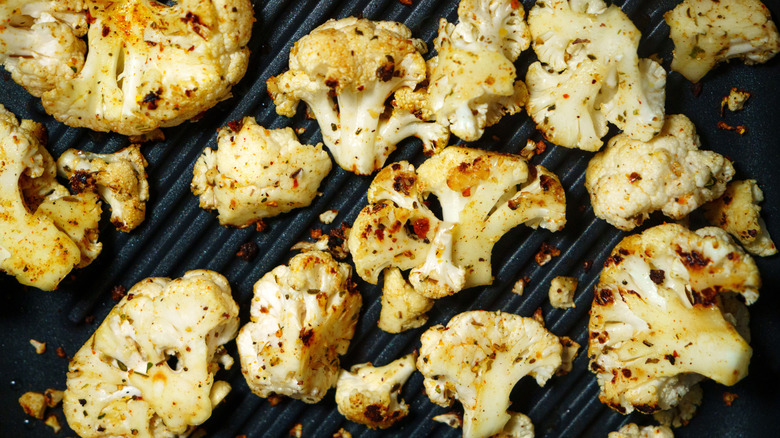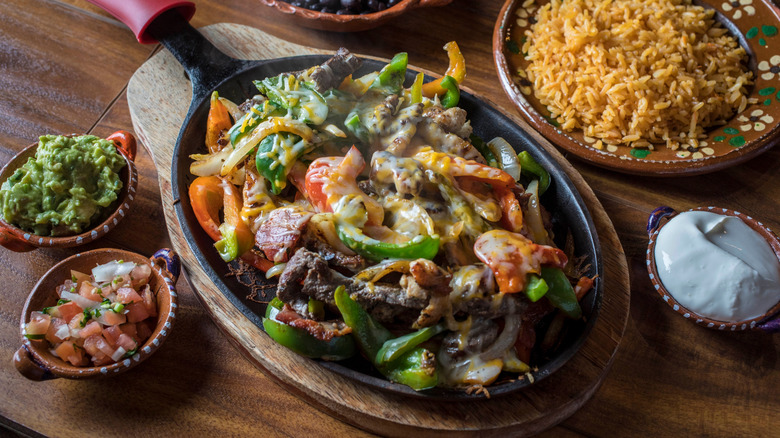11 Rules You Have To Follow When Grilling Fajita Veggies, According To A Chef
We may receive a commission on purchases made from links.
If you are starting to think about grilling weather, no doubt the temperature outside is reaching a comfortable level for such delicious outdoor activities. No matter what you are making this spring, veggies would make a most delicious side. If you are already planning on firing up the grill, do not use another pan inside; instead, use your grill to make some delicious fajita veggies. Sure, they are great with tortillas and toppings, but there is much more you can do with these veggies.
We reached out to Chef Billy Parisi to get his expert insight into the very best rules to follow when grilling up fajita veggies at home. Using grilled fajita veggies in Parisi's steak fajitas is the perfect way to practice these rules. We recommend trying flank or skirt steak if you are looking for the best cut of steak for fajitas. It might seem like a simple process, but there is more that goes into grilling these veggies than you may imagine. So, if the first few times do not yield a most perfect result, keep trying. You will get the hang of it in no time with Parisi's advice.
Choose fire-worthy veggies
The first step to grilling outstanding veggies for fajitas is choosing veggies that are worthy of the cooking experience. Chef Billy Parisi explains that the best options will be vegetables that will be able to "handle fire, like heat" and "actually taste good when a grilling technique is applied." It might seem optimal to just select a variety of colorful veggies, but not all veggies will work best in the fire.
Whatever you would like to grill for your fajitas should be based on your preferences, but try not to limit yourself. Do not be afraid to expand your comfort zone. Since some veggies can stand up better to the char of your grill, it is the perfect place to inject new flavor into your fajitas and try something that might be a new flavor experience. In addition to the frequently used fajita veggies, like onions and peppers, a mix of broccoli, cauliflower, carrots, and parsnips would make for a tasty assortment of veggie options. For the most colorful and flavorful experience, choose veggies that are in season near your home.
Go with an assortment of veggies
No matter which veggies you choose, make the rainbow your goal. Chef Billy Parisi recommends going for "an assortment of veggies" to pair with other ingredients in his fajitas. The breakdown he aims for is "25% protein, 50% veggies, and 25% toppings like cheese, salsa, guacamole, etc." Within that veggie category, there are plenty of grilled vegetables that will taste great in your fajitas.
You probably want to choose veggies that add a range of flavors and textures. This way, your bite of fajita will not just be one type of texture. For that, look to burritos. Consider adding mushrooms for some softer parts and asparagus for a little tougher bite. Since your protein is no doubt going to be a little softer, do not go overboard on choosing soft veggies; that is why peppers and options like asparagus are more ideal. Toppings will only add to that soft feel, unless you are loading on that extra chunky salsa, of course.
Use fajita veggies in other dishes
In addition to fajitas, grilled fajita veggies can go in a variety of dishes. You could even hack your tamales for more exciting vegetarian grilling by grilling veggies wrapped in corn husks. If you prefer your tamales more protein-filled, be sure to balance it out the veggies with meat to help create a satisfying bite.
Chef Billy Parisi tells us that fajita veggies are also "great in stir-frys or just as the side veggie to any pork, fish, chicken, or beef dish." With stir-fry ingredients, it will feel similar to enjoying fajitas without tortillas. When offering fajita veggies as a side to your protein, pay special attention to the texture and flavors of the meal. What you are cooking up should pair well with the main protein. Ideally, it should be enjoyable in the same bite as well as eaten separately. Truth, anything you would typically use cooked veggies in, you could substitute them out for fajita veggies. Granted, you might need to adjust the size of a veggie and how they would be cut or prepared, but the best thing about cooking your own food is that you can create it for exactly the purposes that you might need it for. No one is stopping you from using fajita veggies in your next chicken pot pie, for example. Cooking is all about creativity, and learning how to use fajita veggies in other ways is just one way of being creative on your grill and in your kitchen.
Grill your veggies long enough
Cooking time tends to be the biggest problem home cooks run into when grilling up veggies. Chef Billy Parisi states that, "Folks tend to either not grill them enough where they can get a nice grill flavor or they grill too much and they end up being mushy." Finding the middle ground is going to be the challenge, and that is where a majority of the learning curve will come in.
The best way to avoid short changing your veggies is to do a cook taste test every now and again. When you suspect your veggies are ready, take a sample veggie from the collection, cool it a bit, and take a bite. Keep an eye out for those veggies to be nearly done and pull them right before they seem tender enough. After all, they will cook a little after being removed from heat. You will also want to keep in mind that if you are further cooking them in a stir-fry or through other methods, you will want to pull them out even earlier. A lot of this will depend on trial and error on your part. It might be best to expect that the first few times you grill up fajita veggies, it will be a learning experience, so try not to set your expectations too high or be too hard on yourself if they do not turn out to be the ideal tenderness.
Avoid cooking for too long
While grilling veggies for too little time can create an uncomfortably crunchy bite, cooking them for too long can make for a sloppy mess. Just as he recommends extending your cook time to the perfect degree, Billy Parisi reminds us that "The goal is not to overcook them." Thankfully, there are a few tricks you can do to ensure that your veggies reach that perfect tenderness. For instance, Parisi recommends keeping your veggies, "in bigger sizes like thick slices for the squash or leave the mushrooms whole. This way it will give you a bit of a safety net so they won't cook too quickly." After those pieces finish cooking, you can then prepare them in whatever means you might need for your recipe. That might mean slicing, dicing, or simply quartering. No matter what you need, cooking the veggies as a whole allows for a more even cooking process, but it is less likely to result in mushy veggies.
If all else fails, rely on your senses. Parisi explains that, "If you're worried they are over cooking, pull one off and try it see if they're good to go or need more time. No shame in this. I mean how else do you learn and get better?" Especially if you are new to grilling fajita veggies, it might be worthwhile to grab a few extra veggies in the case that you need to start over after tasting and realizing they are overcooked. At worst, you can use those extra veggies for another meal on a different day.
Contain your veggies with a grill basket
If you know that overcooking your veggies will be a challenge for you, you could choose to use a grill basket. When you do this, chef Billy Parisi recommends cooking those veggies at 450 F. While a grill basket might help you avoid over or undercooking your veggies; it also helps in other ways.
Those who are newer to grilling veggies might suffer from more unique struggles, but there are plenty of tools to help ensure that even newcomers do not have too much trouble. Parisi explains, "Another problem is that people don't use a grill basket to ensure they are keeping all their veggies and they aren't falling through the grates." When using a grill basket, grilling veggies, and keeping them all together becomes much more simple. Grill baskets help ensure that veggies do not fall through the grates, making the whole process much more simple to manage.
There are a few different kinds of grill baskets you could go to. Some of them have open tops that are okay and merely provide a containment system for your veggies. Others are enclosed. And even the enclosed ones come in a few different varieties. Commonly, we have seen ones that have a handle that make them easy to flip. There are also ones that come in more of a barrel style to allow for easy rotating and movement of the contained veggies.
Go simple with marinades
When preparing your veggies for the grill, it might be tempting to go heavy on flavoring. However, veggies do not absolutely need a whole lot of extra prepared seasonings or marinade to really enhance the flavor. On the topic of his go-to marinade, chef Billy Parisi says, "I am very simple and like just salt, pepper, olive oil, and a hint of citrus like lime or lemon. However, you can absolutely use a good spice blend mix to enhance the flavors." If you are one who loves veggies, you will probably want to keep your marinade more simple, but if you are looking to disguise those veggies, you could always go for a little more of a complex option.
A spice blend will probably be your best bet, rather than a prepared liquid marinade. With a spice blend, you have more control over how much you actually add to your veggies to alter their flavor. With the range of spice blends available, the type you choose should depend on the rest of the fajita or dish you are serving.
Let your preparation process guide your cooking
Aside from how to flavor your veggies, the next big question might be exactly how to cut and prepare them. Chef Billy Parisi tells us that "This depends a bit on what kind of cut you want on them. Do you prefer a dice, or do you like them more julienne style?" The specific size of your veggies should depend on the type of food you are serving. Small dices work well when you want the veggies to virtually blend in with what you are making, but if you want the veggies to be one of the stars of the show, you should probably go for a larger slice.
For a small dice, Parisi recommends a method that allows you to cook them right on the grates without falling through. He recommends that you slice your onions and zucchini thickly "and you trim the peppers away from the seeds and stem to have four equal sides. You oil, season, and grill them, let them cool slightly and then dice." Julienne style saves you a little time after cooking because you will be cutting them before you grill. For julienne-style and longer pieces, Parisi advises that you "you slice them [julienne-style], then oil, season, and use a grill basket."
Season your grill
Regardless of the veggies you choose, you will want to take some time to season your grill. Chef Billy Parisi tells us that there are a few different ways to do this. If you want to feel like a real chef, "wrap a folded kitchen towel around some long tongs and tie it up with some butcher's twine to keep it place. Dip it in oil and season the grill." There is nothing quite like doing it the way they do in a restaurant to make your meal feel exceptional.
Alternatively, you could go a little more simply. Parisi recommends that we "dip a folded kitchen towel into some oil and use some long tongs to brush it on." Which oil should you use? Parisi tells us that he likes olive oil and avocado oil for seasoning, and so do we.
Worry less about sear marks
Looks are not everything, especially when it comes to grilling. Though you may aim for those cool grill marks, chef Billy Parisi reminds us that "Cooking time is more critical." You will want to spend more time thinking about how long those veggies have cooked and their tenderness rather than the marks on the veggies. After all, "a beautifully seared onion or pepper can be mushy. For me I'd rather have less sear marks and it be more perfectly cooked throughout." Once the fajita is assembled, you will not even see the grill marks, so do not stress too much.
So, while sear marks are a nice goal, it should not be the only cooking factor. Instead, pay attention to the bite of your veggies and their overall temperature to nail down just when those veggies are done.
Reheat until just warm enough
Invariably, if you cook a large amount of veggies, you will have leftovers. Chef Billy Parisi recommends cooking those leftover veggies on "Super high heat and a few quick tosses in a grill basket, just until warm enough to eat." When reheating, you are not looking for the glamour shot, purely warmth and an ideal temperature for eating.
For leftovers, you should not be aiming to cook the veggies any more. Instead, warm them and dress the fajitas to your heart's content. If you are adding any herbs or fresh veggies, consider cutting new ones for leftover days to keep the resulting fajita tasting fresh, even the next day. Homemade, fresh toppings (like Ina Garten's chunkiest guacamole) or a nice salsa could make all the difference here, too.

